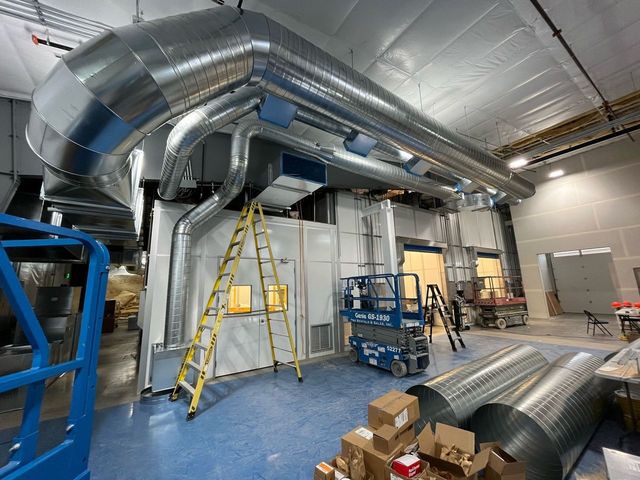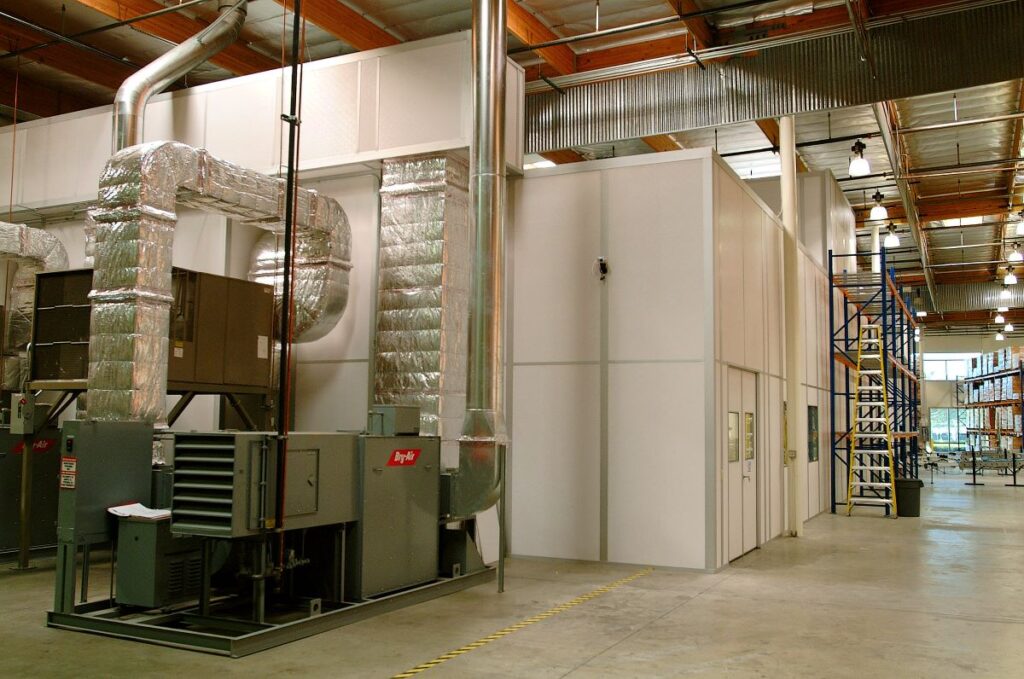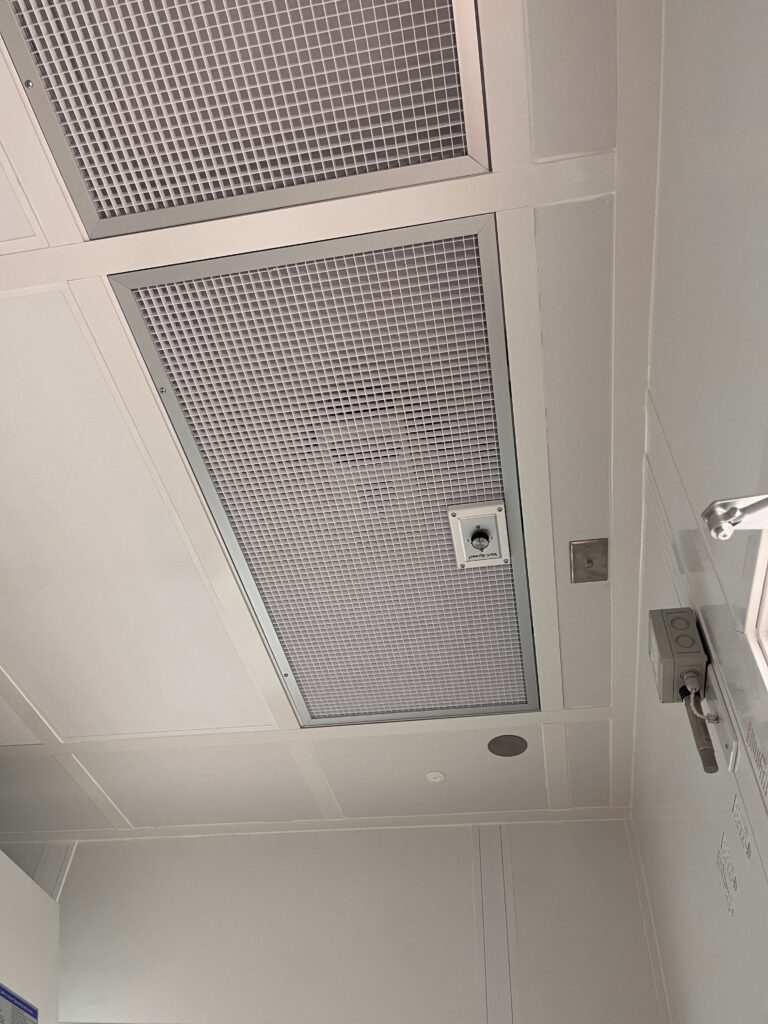
01 Apr What are Cleanroom HVAC Systems? An Overview
In the strict world of cleanrooms, HVAC systems are not just about temperature control or comfort. They are essential in controlling particle contamination and making sure that environments meet the right standards. This overview focuses on the parts, objectives, and filtration strategies of cleanroom HVAC systems.
What are the Main Parts of Cleanroom HVAC Systems?
Air Handling Units
Air handling units (AHUs) are the backbone of HVAC systems. In typical office environments, they are the “base” or “hub” from which the filtered air comes. They usually look like long metal boxes, and they can contain many elements including heating and cooling coils, filters, dampers, and more, depending on the exact conditions needed. They typically connect to ductwork that in turn circulates the air throughout the environment.

In cleanrooms, AHUs can be complex. They may use high-efficiency filters, humidity control elements, and other advanced features to ensure that air is clean, pressurized, and the right temperature and humidity.
A single AHU may be able to meet the ISO Class 7–9 standards in certain environments; however, this of course depends on their size and use. If you need to meet stricter air cleanliness standards, such as ISO Class 6 and above, a single AHU will likely not be enough. Cleanroom engineers often combine multiple components or units to achieve the right standards.
Fan Filter Units
Fan filter units (FFUs) allow for more localized or immediate filtration. They are standalone units, typically much smaller than AHUs. Often installed in the ceiling grid of a cleanroom, FFUs filter air through high-efficiency filters closer to the working environment.

The strictest cleanrooms make use of FFUs, and the need to minimize contamination risks in critical areas within a cleanroom determines FFU placement.
You can also use FFUs to improve air change rates, a metric that measures air freshness, mainly in cleanrooms of ISO Class 7 or above. “Dirtier” rooms generally do not need them.
Recirculation Fan Units
HVAC systems in cleanrooms often include recirculation fan units (RFUs) to recirculate air. While not all cleanrooms need to have air recirculation, this provides much cleaner air, and it can be useful in maintaining equal air distribution throughout an environment.

Larger environments or spaces requiring a cleanliness standard of ISO Class 7 or above might use RFUs.
These units use fans and additional filters to continuously circulate air through the room and back through the HVAC system’s filtration and conditioning equipment.
What are the Objectives of Cleanroom HVAC Systems?
While AHUs, FFUs, and RFUs work together in complex ways in HVAC systems, the objectives of these systems are much easier to understand. Let’s take a look at some of the factors that HVAC systems control.
Airflow Control
The design of HVAC systems often involves airflow management. By managing airflow, cleanrooms can prevent the spread of particles or contaminants.
Airflow patterns can be either laminar (unidirectional) or turbulent (non-unidirectional), depending on the cleanroom’s specific requirements.

Laminar Airflow
In a cleanroom that uses laminar airflow, the air flows either vertically or horizontally at a consistent speed. The higher the speeds, the cleaner the room.

In a vertical laminar flow room, air comes from the ceiling through high-efficiency filters (HEPA/ULPA), often through FFUs. The air then moves toward the returns in the lower parts of the sidewalls or the floor, where it is collected.
On the other hand, if the cleanroom needs to have horizontal airflow, the air flows from one wall and exits through the wall across it.
When set up properly, laminar airflow can quickly remove contamination from people, activities, and equipment.
Turbulent Airflow
By contrast, turbulent airflow moves “randomly” in many directions, without control.

A cleanroom that uses turbulent airflow will always be less clean than one that uses laminar airflow. ISO Class 6 cleanrooms and below typically use turbulent airflow, while laminar airflow is often necessary for ISO 5 cleanrooms and above.
High Air Changes Per Hour
Air changes per hour (ACPH) is another important factor that HVAC systems control. In short, ACPH measures how many times the system replaces the cleanroom’s air each hour; a high number of ACPH keeps cleanrooms clean.
According to The Engineering Toolbox, residential spaces (houses) typically have about one or two ACPH. But in an ISO 7 cleanroom, for example, the ACPH is around 60.
This rate varies significantly across different cleanroom classifications, with stricter environments requiring higher air change rates. The ACPH not only affects the level of cleanliness but also influences the HVAC system’s size and cost.
Pressure Differentials
Maintaining the proper pressure differentials is another important task of HVAC systems in cleanrooms, and this differential can either be positive or negative.
Aerospace, pharmaceutical, and electronic cleanrooms commonly use positive pressure to prevent pollutants from entering. This pressure keeps contaminants outside of cleanrooms, and protects the products or processes that occur there.
On the other hand, negative pressure might be applied in cleanrooms that want to keep contaminants inside. This protects the external environment from dangerous chemicals or biohazards. Virology labs, or other facilities aiming to prevent the spread of hazardous material, might employ negative pressure.
Temperature and Humidity Control
These systems also carefully control temperature and humidity levels. Even small fluctuations of temperature and humidity can drastically affect product quality, especially in pharmaceutical or semiconductor manufacturing.

Controlling humidity in HVAC systems can involve multiple processes, including preheating, adding moisture (humidification), removing moisture (dehumidification), and reheating. Some cleanrooms only need the humidity to stay under a specific threshold, which means they only require equipment to remove moisture but not to add it.
However, other cleanrooms must keep humidity within a narrow range, which means they need the capability to both dehumidify and humidify the air.
Controlling temperature in these systems is just as important to make sure cleanrooms and similar spaces stay comfortable. This involves either warming up or cooling down the air as needed, using various types of equipment within the system. Depending on the room, some places might only need cooling because of heat from machines, while others need both options to handle changes in the outside temperature and keep everything running smoothly.
What Kind of Filters are Used in Cleanroom HVAC Systems?
Filtration is paramount in HVAC systems, especially when it comes to cleanrooms. High-efficiency filters in these systems remove the smallest particles with ease, helping cleanrooms reach their proper standards. Multiple stages of filtration remove excess particles at every step.
HEPA and ULPA Filters
The heart of any cleanroom HVAC system lies, of course, in its ability to filter particles. These systems make use of dense filters (often made from fiberglass) that are capable of trapping small particles with high efficiency.
High-efficiency particulate air (HEPA) filters stop 99.97% of particles 0.3 micrometers or larger. And similarly, ultra-low particulate air (ULPA) filters stop 99.99% of particles that are .12 micrometers or larger.

HVAC systems in cleanrooms use these filters extensively, selecting their type and quantity to match the cleanroom’s operational needs and the sizes of particles that need filtering.
Filtration Stages
HVAC systems often employ a multi-stage filtration process. This begins with pre-filters, which capture large particles. (This extends the life of the more expensive main filters.) Cleanroom spaces often situate HEPA or ULPA main filters nearby to ensure the air meets cleanliness standards before it enters.
Cleanroom HVAC Systems in a Nutshell
HVAC systems are a necessary element in any cleanroom environment. They vary greatly, and engineers use a range of tools to meet cleanroom objectives. Whether you’re upgrading or building from scratch, the experts at Allied Cleanrooms can help you sort out the right HVAC solution for your cleanroom. With tailored solutions that ensure compliance and efficiency, we’re here to support your project’s success. Start on your cleanroom today.

